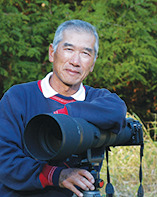During the past year we profiled teachers who, for a variety of reasons, have continued, in one way or another, to teach in their retirement. In this issue, we talk to Mike Yip, a photographer of extraordinary talent, who chose to combine his teaching skills and his hobby after retirement. He has done that by taking on the job of increasing public awareness about the beauty and fragility of the birds and butterflies that live close to where he lives. Mike photographs, writes and presents talks about what he refers to as the “canary in the coal mine” of Canada’s west coast. Mike’s joy and concern are equally palpable in his writing and in his talks as this quiet, dedicated former teacher uses his retirement to affect change and enhance life for himself and his subjects. As you’ll see when you read his responses to our questions, his philosophy is clear, just like his seemingly simple and beautiful photographs.
 What was your original area of work in education?
What was your original area of work in education?
I taught at all levels of public school—elementary, middle, and high school, Grades 3 to 12. I also worked as a native language coordinator in Inuvik, NWT and as a Learning Assistance Teacher at a secondary school before ending my teaching career at an alternate school.
How many years did you work within the educational system?
I worked for 33.5 years in the public system.
What type of work/volunteering are you now involved in?
I write an online magazine about the birds of Vancouver Island and I’ve self-published five books. I have also written over 100 newspaper articles and presented more than 70 talks on the subject in the past ten years. If you are interested, my online magazine website is: vancouverislandbirds.com.
What were your reasons for deciding to continue to work after retirement?
Photography is self-fulfilling on its own, but the satisfaction is multiplied many times if it can be shared with others, especially if the subject matter promotes environmental awareness and conservation.
What made you decide on this particular type of work/volunteering?
Bird and butterfly photography is, in my opinion, totally addictive. There is so much beauty and fascination in the natural world that it begs to be discovered, photographed and shared.
What challenges did you encounter in your new endeavour that you did not expect and how did you deal with them?
There was only one real challenge and that was the initial cost of film photography. Once I got into digital photography, it not only became affordable, but it also gave me total control of post-production.
What have been the rewards of your new endeavour?
The regular compliments and thanks for my publications and articles have been gratifying. The many requests for my presentations reaffirm my self-worth and have also given me added purpose to continue.
What impact if any has your choice had on your life in general?
Besides the pleasure of doing photography and enjoying nature, the challenge of self-publishing and writing has been an excellent way to maintain my creativity and mental abilities.
Where you ever worried that you might have made a mistake in your choice? Did you have a Plan B?
I had always enjoyed photography, and the discovery of birds and butterflies inspired me to take it to the next level. The evolution to writing newspaper articles, self-publishing and public speaking was a natural progression that I enjoyed. If I hadn’t, I wouldn’t have done it. I haven’t thought of a Plan B.
Did your new position require special training?
My photography and self-publishing skills are all self-taught, so as a do-it-yourself type of person, I learned as I went.
How has your background in education helped in what you are now doing?
It was actually the opposite—my self-taught skills in photography and self-publishing were useful in expanding my repertoire of teaching abilities when teaching basic photography and yearbook classes.
How long do you intend/hope to be doing this type of work?
I have been totally engrossed in these activities for the past ten years, but now I must slow down and catch up with domestic chores like completing the house I started 30 years ago!
What advice would you give to other educators interested in pursuing the same type of work/volunteering that you are involved with?
Photography is a great way to expand your knowledge of nature, and there are always lots of people who will and can enjoy your efforts. So I say, go for it!
Any further thoughts or comments about your retirement choice?
Don’t put off any special interest or desires while you’re capable because you never know what will happen tomorrow.
Is it time to retire? That is a decision that is unique to the person asking the question and the answer is sometimes dictated by what the individual sees ahead of themselves—positive or negative. In Mike’s particular situation, having an engrossing hobby helped him to look at the possibilities of expanding it into something else, while continuing to learn and teach. As we suggest in our book, Transition to Retirement, looking to what you’ve enjoyed doing in your spare time can lead you to a rewarding and meaningful retirement, as it did for Mike. Regardless of what you choose to do, we think Mike’s story has some good pointers that may help you to plan your own unique and happy journey into retirement.
ABOUT THE AUTHORS
Carol Baird-Krul & Enise Olding
Carol and Enise (info@drassociates.ca) are the creators of a series of pre-retirement and post-retirement planning workshops: Transition to Retirement: The Uncharted Course©, Recently Retired: Charting a New Course© and Ideas… Enhanced and Advanced©, and authors of Transition to Retirement: The Uncharted Course. Previous articles on retirement may be viewed in back issues at CanadianTeacherMagazine.com.
This article is from Canadian Teacher Magazine’s Sept/Oct 2015 issue.









